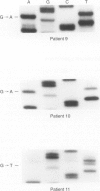Abstract
Increased understanding of the molecular basis of colorectal cancer and recognition that extracellular DNA circulates in the plasma and serum of cancer patients enables new approaches to detection and monitoring. We used a polymerase chain reaction (PCR) assay to demonstrate mutant K-ras DNA in the plasma or serum of patients with colorectal cancer. Plasma or serum was fractionated from the blood of 31 patients with metastatic or unresected colorectal cancer and from 28 normal volunteers. DNA was extracted using either a sodium chloride or a gelatin precipitation method and then amplified in a two-stage PCR assay using selective restriction enzyme digestion to enrich for mutant K-ras DNA. Mutant K-ras DNA was detected in the plasma or serum of 12 (39%) patients, all confirmed by sequencing, but was not detected in any of the normal volunteers. K-ras mutations were detected in plasma or serum regardless of sex, primary tumour location, principal site of metastasis or proximity of chemotherapy and surgery to blood sampling. Tumour specimens available for 19 of the patients were additionally assayed for ras mutations and compared with blood specimens. Our results indicate mutant K-ras DNA is readily detectable by PCR in the plasma or serum of patients with advanced colorectal cancer. Thus, plasma- or serum-based nucleic acid amplification assays may provide a valuable method of monitoring and potentially detecting colorectal cancer.
Full text
PDF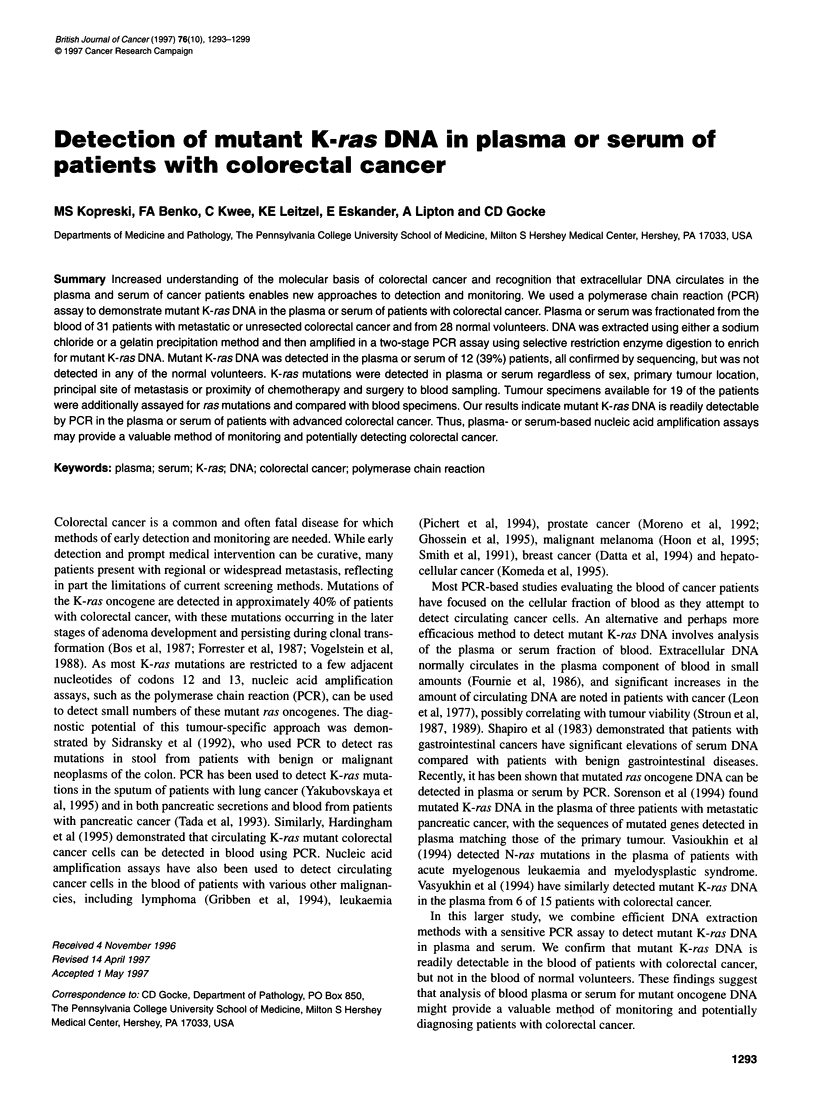
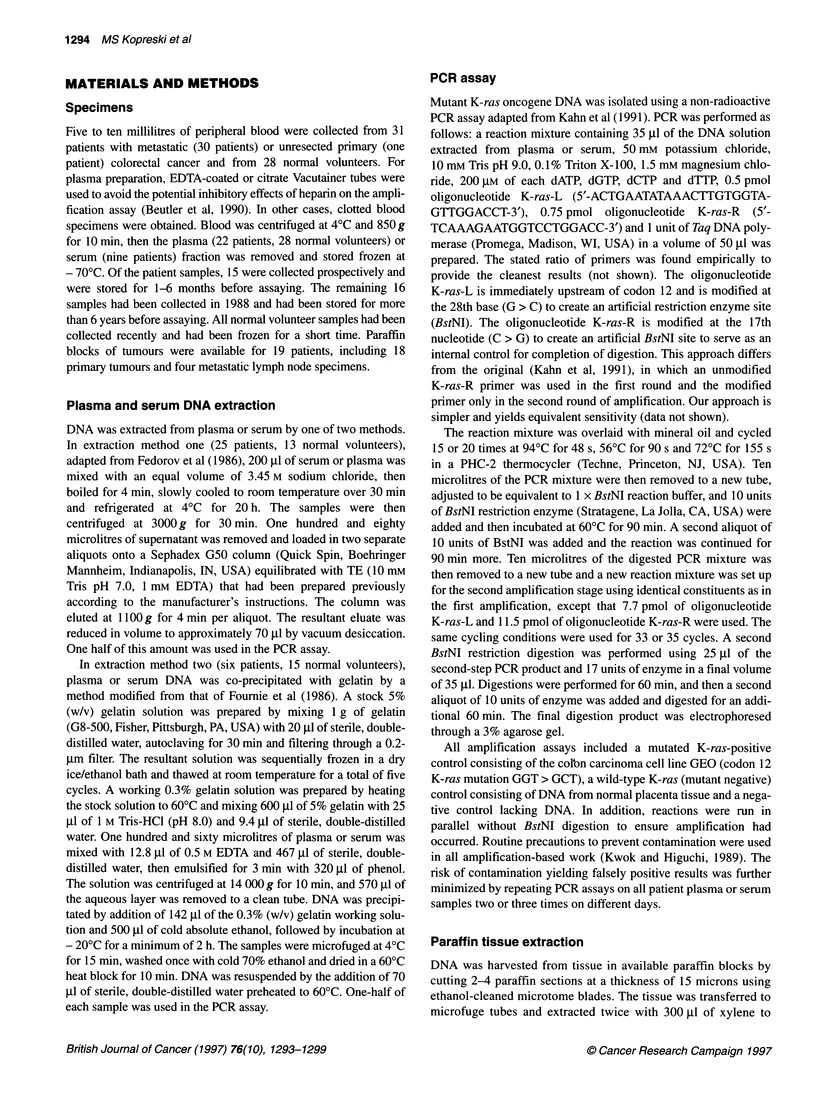


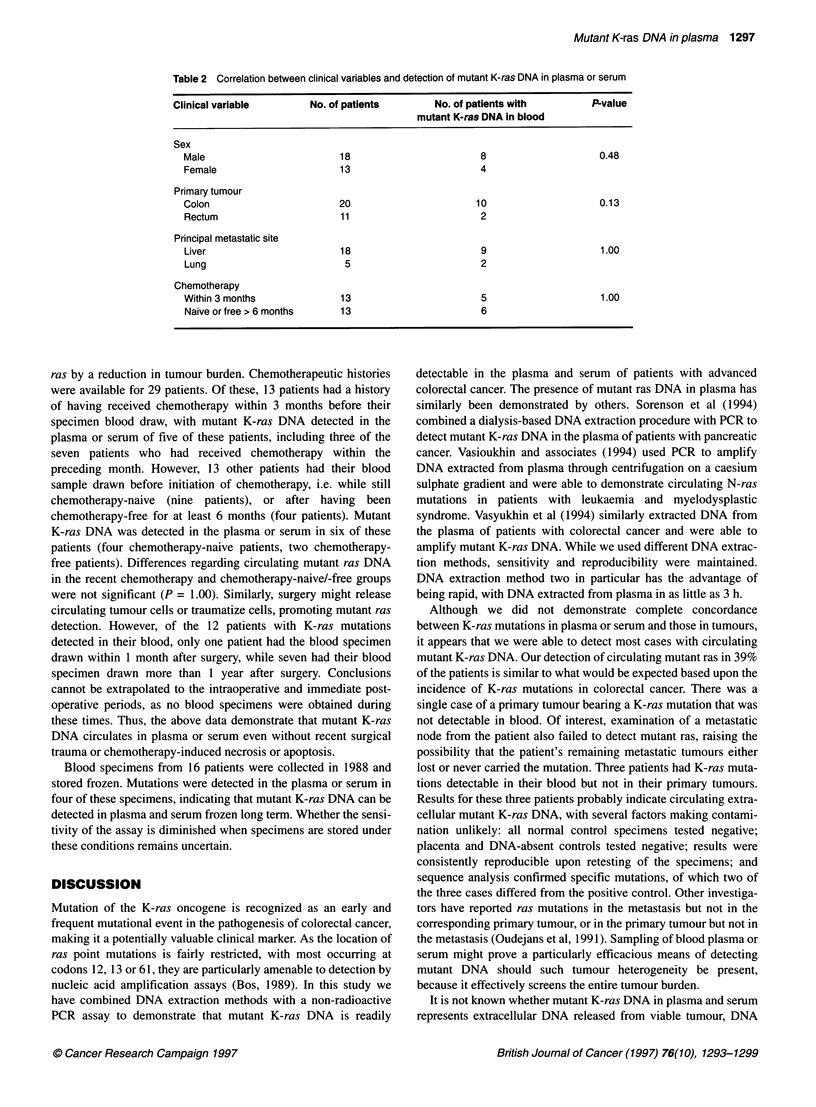
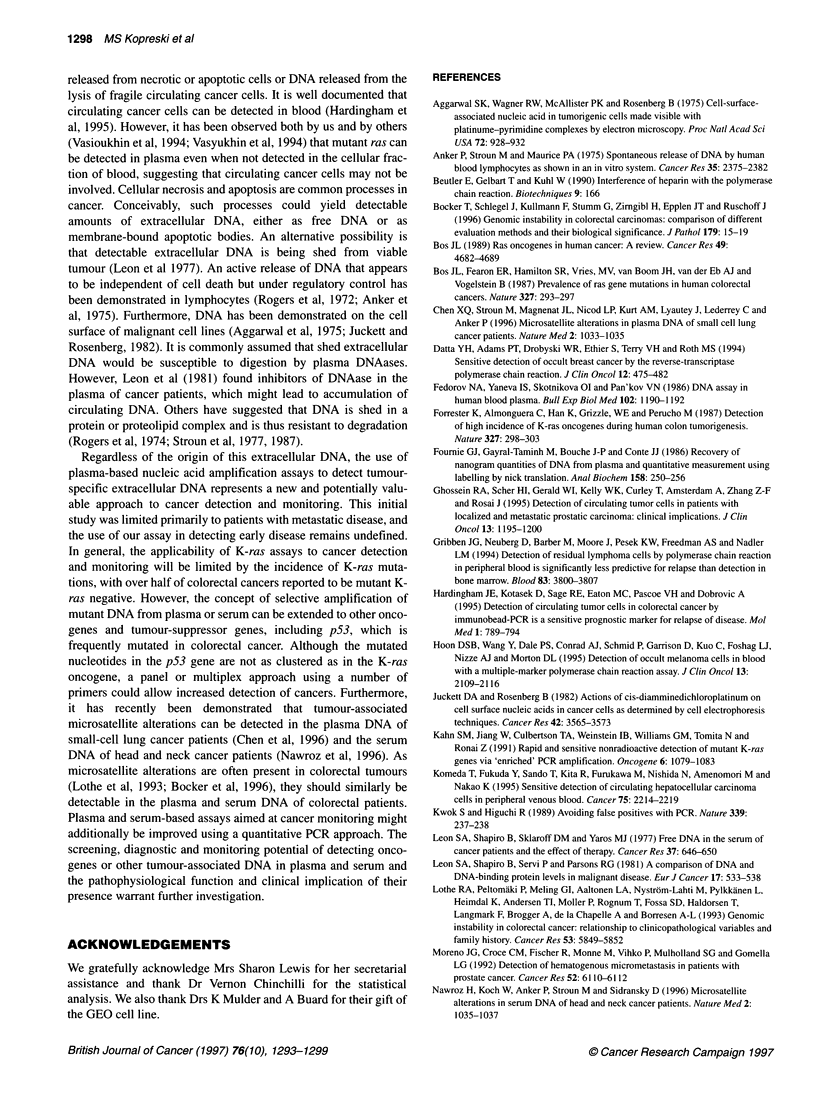

Images in this article
Selected References
These references are in PubMed. This may not be the complete list of references from this article.
- Aggarwal S. K., Wagner R. W., McAllister P. K., Rosenberg B. Cell-surface-associated nucleic acid in tumorigenic cells made visible with platinum-pyrimidine complexes by electron microscopy. Proc Natl Acad Sci U S A. 1975 Mar;72(3):928–932. doi: 10.1073/pnas.72.3.928. [DOI] [PMC free article] [PubMed] [Google Scholar]
- Anker P., Stroun M., Maurice P. A. Spontaneous release of DNA by human blood lymphocytes as shown in an in vitro system. Cancer Res. 1975 Sep;35(9):2375–2382. [PubMed] [Google Scholar]
- Beutler E., Gelbart T., Kuhl W. Interference of heparin with the polymerase chain reaction. Biotechniques. 1990 Aug;9(2):166–166. [PubMed] [Google Scholar]
- Bocker T., Schlegel J., Kullmann F., Stumm G., Zirngibl H., Epplen J. T., Rüschoff J. Genomic instability in colorectal carcinomas: comparison of different evaluation methods and their biological significance. J Pathol. 1996 May;179(1):15–19. doi: 10.1002/(SICI)1096-9896(199605)179:1<15::AID-PATH553>3.0.CO;2-N. [DOI] [PubMed] [Google Scholar]
- Bos J. L., Fearon E. R., Hamilton S. R., Verlaan-de Vries M., van Boom J. H., van der Eb A. J., Vogelstein B. Prevalence of ras gene mutations in human colorectal cancers. 1987 May 28-Jun 3Nature. 327(6120):293–297. doi: 10.1038/327293a0. [DOI] [PubMed] [Google Scholar]
- Bos J. L. ras oncogenes in human cancer: a review. Cancer Res. 1989 Sep 1;49(17):4682–4689. [PubMed] [Google Scholar]
- Chen X. Q., Stroun M., Magnenat J. L., Nicod L. P., Kurt A. M., Lyautey J., Lederrey C., Anker P. Microsatellite alterations in plasma DNA of small cell lung cancer patients. Nat Med. 1996 Sep;2(9):1033–1035. doi: 10.1038/nm0996-1033. [DOI] [PubMed] [Google Scholar]
- Datta Y. H., Adams P. T., Drobyski W. R., Ethier S. P., Terry V. H., Roth M. S. Sensitive detection of occult breast cancer by the reverse-transcriptase polymerase chain reaction. J Clin Oncol. 1994 Mar;12(3):475–482. doi: 10.1200/JCO.1994.12.3.475. [DOI] [PubMed] [Google Scholar]
- Forrester K., Almoguera C., Han K., Grizzle W. E., Perucho M. Detection of high incidence of K-ras oncogenes during human colon tumorigenesis. 1987 May 28-Jun 3Nature. 327(6120):298–303. doi: 10.1038/327298a0. [DOI] [PubMed] [Google Scholar]
- Fournié G. J., Gayral-Taminh M., Bouché J. P., Conté J. J. Recovery of nanogram quantities of DNA from plasma and quantitative measurement using labeling by nick translation. Anal Biochem. 1986 Nov 1;158(2):250–256. doi: 10.1016/0003-2697(86)90545-2. [DOI] [PubMed] [Google Scholar]
- Ghossein R. A., Scher H. I., Gerald W. L., Kelly W. K., Curley T., Amsterdam A., Zhang Z. F., Rosai J. Detection of circulating tumor cells in patients with localized and metastatic prostatic carcinoma: clinical implications. J Clin Oncol. 1995 May;13(5):1195–1200. doi: 10.1200/JCO.1995.13.5.1195. [DOI] [PubMed] [Google Scholar]
- Gribben J. G., Neuberg D., Barber M., Moore J., Pesek K. W., Freedman A. S., Nadler L. M. Detection of residual lymphoma cells by polymerase chain reaction in peripheral blood is significantly less predictive for relapse than detection in bone marrow. Blood. 1994 Jun 15;83(12):3800–3807. [PubMed] [Google Scholar]
- Hardingham J. E., Kotasek D., Sage R. E., Eaton M. C., Pascoe V. H., Dobrovic A. Detection of circulating tumor cells in colorectal cancer by immunobead-PCR is a sensitive prognostic marker for relapse of disease. Mol Med. 1995 Nov;1(7):789–794. [PMC free article] [PubMed] [Google Scholar]
- Hoon D. S., Wang Y., Dale P. S., Conrad A. J., Schmid P., Garrison D., Kuo C., Foshag L. J., Nizze A. J., Morton D. L. Detection of occult melanoma cells in blood with a multiple-marker polymerase chain reaction assay. J Clin Oncol. 1995 Aug;13(8):2109–2116. doi: 10.1200/JCO.1995.13.8.2109. [DOI] [PubMed] [Google Scholar]
- Juckett D. A., Rosenberg B. Actions of cis-diamminedichloroplatinum on cell surface nucleic acids in cancer cells as determined by cell electrophoresis techniques. Cancer Res. 1982 Sep;42(9):3565–3573. [PubMed] [Google Scholar]
- Kahn S. M., Jiang W., Culbertson T. A., Weinstein I. B., Williams G. M., Tomita N., Ronai Z. Rapid and sensitive nonradioactive detection of mutant K-ras genes via 'enriched' PCR amplification. Oncogene. 1991 Jun;6(6):1079–1083. [PubMed] [Google Scholar]
- Komeda T., Fukuda Y., Sando T., Kita R., Furukawa M., Nishida N., Amenomori M., Nakao K. Sensitive detection of circulating hepatocellular carcinoma cells in peripheral venous blood. Cancer. 1995 May 1;75(9):2214–2219. doi: 10.1002/1097-0142(19950501)75:9<2214::aid-cncr2820750905>3.0.co;2-x. [DOI] [PubMed] [Google Scholar]
- Kwok S., Higuchi R. Avoiding false positives with PCR. Nature. 1989 May 18;339(6221):237–238. doi: 10.1038/339237a0. [DOI] [PubMed] [Google Scholar]
- Leon S. A., Shapiro B., Servi P., Parsons R. G. A comparison of DNA and DNA-binding protein levels in malignant disease. Eur J Cancer. 1981 May;17(5):533–538. doi: 10.1016/0014-2964(81)90055-4. [DOI] [PubMed] [Google Scholar]
- Leon S. A., Shapiro B., Sklaroff D. M., Yaros M. J. Free DNA in the serum of cancer patients and the effect of therapy. Cancer Res. 1977 Mar;37(3):646–650. [PubMed] [Google Scholar]
- Lothe R. A., Peltomäki P., Meling G. I., Aaltonen L. A., Nyström-Lahti M., Pylkkänen L., Heimdal K., Andersen T. I., Møller P., Rognum T. O. Genomic instability in colorectal cancer: relationship to clinicopathological variables and family history. Cancer Res. 1993 Dec 15;53(24):5849–5852. [PubMed] [Google Scholar]
- Moreno J. G., Croce C. M., Fischer R., Monne M., Vihko P., Mulholland S. G., Gomella L. G. Detection of hematogenous micrometastasis in patients with prostate cancer. Cancer Res. 1992 Nov 1;52(21):6110–6112. [PubMed] [Google Scholar]
- Nawroz H., Koch W., Anker P., Stroun M., Sidransky D. Microsatellite alterations in serum DNA of head and neck cancer patients. Nat Med. 1996 Sep;2(9):1035–1037. doi: 10.1038/nm0996-1035. [DOI] [PubMed] [Google Scholar]
- Pichert G., Alyea E. P., Soiffer R. J., Roy D. C., Ritz J. Persistence of myeloid progenitor cells expressing BCR-ABL mRNA after allogeneic bone marrow transplantation for chronic myelogenous leukemia. Blood. 1994 Oct 1;84(7):2109–2114. [PubMed] [Google Scholar]
- Rogers J. C., Boldt D., Kornfeld S., Skinner A., Valeri C. R. Excretion of deoxyribonucleic acid by lymphocytes stimulated with phytohemagglutinin or antigen. Proc Natl Acad Sci U S A. 1972 Jul;69(7):1685–1689. doi: 10.1073/pnas.69.7.1685. [DOI] [PMC free article] [PubMed] [Google Scholar]
- Shapiro B., Chakrabarty M., Cohn E. M., Leon S. A. Determination of circulating DNA levels in patients with benign or malignant gastrointestinal disease. Cancer. 1983 Jun 1;51(11):2116–2120. doi: 10.1002/1097-0142(19830601)51:11<2116::aid-cncr2820511127>3.0.co;2-s. [DOI] [PubMed] [Google Scholar]
- Sidransky D., Tokino T., Hamilton S. R., Kinzler K. W., Levin B., Frost P., Vogelstein B. Identification of ras oncogene mutations in the stool of patients with curable colorectal tumors. Science. 1992 Apr 3;256(5053):102–105. doi: 10.1126/science.1566048. [DOI] [PubMed] [Google Scholar]
- Smith B., Selby P., Southgate J., Pittman K., Bradley C., Blair G. E. Detection of melanoma cells in peripheral blood by means of reverse transcriptase and polymerase chain reaction. Lancet. 1991 Nov 16;338(8777):1227–1229. doi: 10.1016/0140-6736(91)92100-g. [DOI] [PubMed] [Google Scholar]
- Sorenson G. D., Pribish D. M., Valone F. H., Memoli V. A., Bzik D. J., Yao S. L. Soluble normal and mutated DNA sequences from single-copy genes in human blood. Cancer Epidemiol Biomarkers Prev. 1994 Jan-Feb;3(1):67–71. [PubMed] [Google Scholar]
- Stroun M., Anker P., Lyautey J., Lederrey C., Maurice P. A. Isolation and characterization of DNA from the plasma of cancer patients. Eur J Cancer Clin Oncol. 1987 Jun;23(6):707–712. doi: 10.1016/0277-5379(87)90266-5. [DOI] [PubMed] [Google Scholar]
- Stroun M., Anker P., Maurice P., Gahan P. B. Circulating nucleic acids in higher organisms. Int Rev Cytol. 1977;51:1–48. doi: 10.1016/s0074-7696(08)60225-9. [DOI] [PubMed] [Google Scholar]
- Stroun M., Anker P., Maurice P., Lyautey J., Lederrey C., Beljanski M. Neoplastic characteristics of the DNA found in the plasma of cancer patients. Oncology. 1989;46(5):318–322. doi: 10.1159/000226740. [DOI] [PubMed] [Google Scholar]
- Tada M., Omata M., Kawai S., Saisho H., Ohto M., Saiki R. K., Sninsky J. J. Detection of ras gene mutations in pancreatic juice and peripheral blood of patients with pancreatic adenocarcinoma. Cancer Res. 1993 Jun 1;53(11):2472–2474. [PubMed] [Google Scholar]
- Vasioukhin V., Anker P., Maurice P., Lyautey J., Lederrey C., Stroun M. Point mutations of the N-ras gene in the blood plasma DNA of patients with myelodysplastic syndrome or acute myelogenous leukaemia. Br J Haematol. 1994 Apr;86(4):774–779. doi: 10.1111/j.1365-2141.1994.tb04828.x. [DOI] [PubMed] [Google Scholar]
- Vogelstein B., Fearon E. R., Hamilton S. R., Kern S. E., Preisinger A. C., Leppert M., Nakamura Y., White R., Smits A. M., Bos J. L. Genetic alterations during colorectal-tumor development. N Engl J Med. 1988 Sep 1;319(9):525–532. doi: 10.1056/NEJM198809013190901. [DOI] [PubMed] [Google Scholar]
- Yakubovskaya M. S., Spiegelman V., Luo F. C., Malaev S., Salnev A., Zborovskaya I., Gasparyan A., Polotsky B., Machaladze Z., Trachtenberg A. C. High frequency of K-ras mutations in normal appearing lung tissues and sputum of patients with lung cancer. Int J Cancer. 1995 Dec 11;63(6):810–814. doi: 10.1002/ijc.2910630611. [DOI] [PubMed] [Google Scholar]




